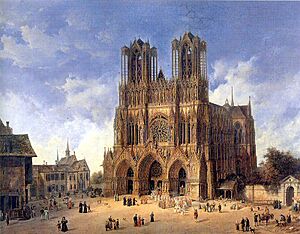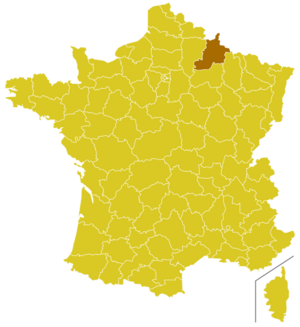Roman Catholic Archdiocese of Reims facts for kids
The Archdiocese of Reims (pronounced "Rance") is an important area of the Catholic Church in France. It's like a special church district led by an archbishop. This area was first set up as a smaller church district (a diocese) around the year 250 AD. Later, around 750 AD, it became an archdiocese, which is a larger and more important church area.
In 1089, the archbishop of Reims was given a special title: "primate of Gallia Belgica". This meant he was a very important church leader in that part of Europe.
Between 1060 and 1170, the archbishop also became a powerful ruler, like a prince. He was known as a "prince-bishop" and was even part of the French nobility.
Today, the archdiocese covers the city of Reims and the Ardennes region. It's part of a larger church province that includes other church districts like Amiens, Beauvais, Châlons, Langres, Soissons, and Troyes.
The main church for the archdiocese is the famous Cathedral of Notre-Dame of Reims. This is a very special place because many Kings of France were traditionally crowned there.
In 2018, Pope Francis chose Éric de Moulins-Beaufort to be the current Archbishop of Reims.
Quick facts for kids Archdiocese of ReimsArchidiœcesis Remensis Archidiocèse de Reims |
|
|---|---|

The Cathedral of Reims, by Domenico Quaglio
|
|

Coat of arms
|
|
| Location | |
| Country | France |
| Ecclesiastical province | Reims |
| Statistics | |
| Area | 6,931 km2 (2,676 sq mi) |
| Population - Total - Catholics |
(as of 2017) 607,579 564,500 (guess) (92.9%) |
| Parishes | 76 'new parishes' |
| Information | |
| Denomination | Catholic |
| Sui iuris church | Latin Church |
| Rite | Roman Rite |
| Established | 3rd Century (As Diocese of Reims) 4th Century (As Archdiocese of Reims) |
| Cathedral | Cathedral of Notre Dame of Reims |
| Patron saint | Saint Remigius |
| Secular priests | 94 (diocesan) 9 (Religious orders) 33 Permanent Deacons |
| Current leadership | |
| Pope | Francis |
| Metropolitan Archbishop | Éric de Moulins-Beaufort |
| Auxiliary Bishops | Étienne Emmanuel Vetö |
| Emeritus Bishops | Thierry Jordan Joseph Louis Jean Boishu |
| Map | |
 |
|
Contents
A Look Back: History of Reims
The city of Reims has a long and interesting history. It has seen many important events over the centuries.
- In 406 AD, the city was taken over by a group called the Vandals.
- A very important event happened in 497 AD. Clovis, a powerful Frankish king, was baptized and crowned by Archbishop Remigius of Reims. This was a key moment for Christianity in France.
- In 719 AD, the city was attacked and damaged by Charles Martel, a famous military leader.
- In 816 AD, Pope Stephen IV crowned Louis the Pious as Emperor in Reims.
- On January 28, 893 AD, Charles III, also known as "the Simple," was crowned King of West Francia in Reims.
- King Robert I was crowned King of the Franks in Reims on June 29, 922 AD.
- Hugh Capet, who started a new line of French kings, was crowned in Reims on Christmas Day in 988 AD.
Important Meetings: Councils of Reims
Over the years, several important church meetings, called councils, have taken place in Reims.
- The First Council of Reims happened in 625 AD. It was led by Archbishop Sonnatius and created 25 church rules.
- Another big council took place in 1049 AD. Pope Leo IX himself led this meeting, with many bishops and abbots attending. The Pope was in Reims to dedicate a new church at the Saint-Rémi monastery.
Leaders of the Church: Bishops and Archbishops
The Archdiocese of Reims has been led by many bishops and archbishops throughout its history. These leaders played a big role in both the church and the region.
Early Bishops of Reims
The first known bishop was St. Sixtus around 260 AD. Another very famous early bishop was Saint Remigius (Remi), who served from 459 to 533 AD and baptized King Clovis.
Archbishops of Reims
After the diocese became an archdiocese, its leaders were called archbishops.
- Tilpin was one of the first archbishops, serving from 748 to 795 AD.
- Hincmar (845–882 AD) was a very influential archbishop.
- Adalberon (969–988 AD) crowned Hugh Capet.
- Gerbert of Aurillac (991–996 AD) later became Pope Sylvester II.
- More recently, Thierry Jordan served from 1999 to 2018.
- The current archbishop, appointed in 2018, is Éric de Moulins-Beaufort.
Other Important Roles
Sometimes, an archdiocese has "auxiliary bishops" who help the main archbishop.
- One such auxiliary bishop mentioned was Abel de Saint-Brieuc in 1483.
See also
- Catholic Church in France
- Council of Reims

